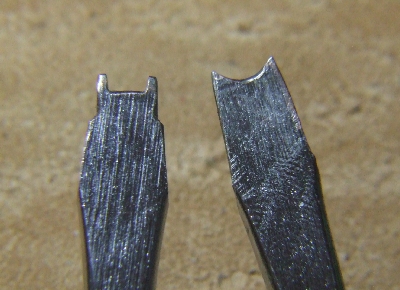-
Posts
5,928 -
Joined
Content Type
Profiles
Forums
Events
Blogs
Gallery
Everything posted by fredk
-

So I made a thing. For another thing.
fredk replied to immiketoo's topic in Gun Holsters, Rifle Slings and Knife Sheathes
Very nice work indeedy The screws are pozi-drive [or Phillips drive] counter-sunk head screws or machine screws set into screw cups - depends on what Mike has on the other side, if anything I use brass screw cups to back yellow or gold rhinestone rivets and shiny nickle-plated ones for silver and coloured rhinestones. Holds em better and makes em look a bit bigger -
Saw another use of WTF? today WTF? "Where's the Food?"
- 24 replies
-

Spartan short sword sheath.
fredk replied to immiketoo's topic in Gun Holsters, Rifle Slings and Knife Sheathes
That is nice -
Basically you only need to allow for the thickness of the leather to be used, and most times you don't even need to do that. A male fitting tightly into the female part will just sit further out when leather is put between. The only time you really need to consider leaving a size difference is if you are using a buck and a frame around it to press the leather down over it
-
In the UK you can buy a car leather upholstery cleaner which will give off a 'new leather' smell after use. Car dealers use it on both new cars and used cars. The cleaner works on the PVC and plastic parts as well, shining them up but adding that 'leather' smell
-
I've not received an email about this and there is nowt on their website about it
-
In RAF we had one very important one; WOP....... Warrant-Officer on Prowl Its not so much the abbreviations, which are now quite common, but the names of everyday things that can cause confusion eg; US truck = UK pick-up. in UK a truck is a heavy goods vehicle weighing 3 tons or more or a small light weight wheeled vehicle for handling very large goods US, bill-fold, UK - wallet.
- 24 replies
-
Almost all those abbreviations are standard fare in the UK, mainly due to t'internetty Not all British slang comes from Cockney!* TTFN was a popular phrase coined by a favourite radio presenter called Jimmy Young * in fact most British slang has nowt to do with them sort of Londoners IMHO = here, mostly is In My Humble Opinion we separate ATM from atm. But it is extremely rare for anyone here to ask for an ATM; they usually call it a 'hole in the wall' or 'cash point' Old one which still causes confusion; LOL - to some = Laughs Out Loud, to some = Lots Of Love afair, it was Lots Of Love originally to the British, but the US and international Laugh.... took over; thus older users use it for Love WTF; has a clean form, = Why The Face?
- 24 replies
-
I did this game board about 15 years ago using a gold gel ink pen; I also use metallic ink pens by Molotow and also paint pens No problems so far. But seal the ink with resolene or something similar; the ink remains water soluble. If your item gets in the least bit wet the ink will thin and run.
-
I would 'wash' them down with lots of cellulose [lacquer] thinners and clean rags; until they are about dry of that oil, then apply neetsfoot oil to restore the lost oil, but not as much nfo, just enough to feed the leather
-
Taking a random sampling, we in the UK are paying approx 50% more than you in Canada for the same item, plus you have items in that flyer that are not in mine
-

What did the old shoe and boot makers use to waterproof them
fredk replied to chrisash's topic in How Do I Do That?
They also used shellac varnish. I believe shellac is still used on the boots of the Household Cavalry, the long ones worn for official duties -
A nice thing to solve the problem. Did you prep your leather before dyeing? I give mine a wipe over with a clean rag dampened with cellulose (aka lacquer) thinners to remove any surface contamination. Even some grease from your fingers can leave contamination which will prevent dye penetrating properly
-
Most excellent The kid wot rides that will need a leather jacket and cap. ala Marlon Brando in 'The Wild One'
-
I bought a brass one from a Chinese seller on ebay
-

Can I make a molded hat visor rain-resistant?
fredk replied to DanDSilva's topic in How Do I Do That?
Seal the dye with several coats of diluted Resolene. Then apply several coats of Snow Proof paste. Even apply some soft bees wax and buff it in. Then it will be rain-shower resistant, but not totally rain proof, it will never be that -
Found square head Chicago screws https://www.ebay.co.uk/itm/Solid-Brass-Square-Head-Binding-Stud-Leather-Belt-Bag-Chicago-Screw-Nail-Rivet/152694517062?hash=item238d4d6d46:m:mjGLK7T9Mvki-qyv6zAuvxw
-
double; I know you can't cut the edges and retain the integrity of the rivet head. Cutting off one part of the edge is one way I use to remove them. The Chicago screws is the way I think. You can buy square ones from Chinese sellers on ebay
-
A; when someone goes to lawyer and says 'I have copyright on this' the lawyer takes his/her word for it and does not investigate if they have. They act on the word of their client B. Its very, very expensive to take a court case. In N.I. a copyright case is a civil action and the complainant has to lodge a minimum of £10, 000 ~ in cash, with the court before proceeding C. I've had threats by lawyer letter over copyright ownership (I never infringe anyone's proper copyrights). I have just written a letter back to the lawyer; telling them 'no they don't have copyright' give an example or two, and tell them to prove it in court. Thats the last I've heard from them. An eg; when I had a wooden toy company it was called 'Tyrone Toys'. Shortly after I started it I got a lawyers letter saying I infringed his clients copyright, his company name was 'County Tyrone Toys'. The letter told me the date from when the client had used the name, which predated the first of my toys going on sale. I sent back to the lawyer a newspaper advert and the company registration papers for my 'Tyrone Toys' which both predated his clients claim and told him' see you in court'. btw the other toy company changed to 'Wooden Toys of Co.Tyrone'
-
Big cheat; get the Tandy Craftaids. They have them all drawn out. Also Tandy have a 'library' where you can buy older designs. Prices are from $0.00 upwards. These come to you as PDF files. With these you can resize and squeeze or expand in your computer to suit your item, then print out, trace over on your item then go to work on it. It suits me cos I'm no artist Floral design craftaid example; https://www.tandyleather.eu/en/product/floral-keycase-belt-craftaid from the 'library'; https://www.leathercraftlibrary.com/p-1743-sheridan-floral-corner-and-belt-pattern-by-jim-linnell.aspx https://www.leathercraftlibrary.com/p-1739-2681-floral-belt-craftaid-tracing.aspx
-
Try searching outside of leather work items. Model railway boiler rivets; https://www.ebay.co.uk/itm/1-16-x-5-8-brass-rivets-round-head-snap-head/232802078698?hash=item363415cfea:m:mWtAA9QFjYHGGtJWdcewASg
-

Rune bags & some questions.
fredk replied to mick86's topic in Purses, Wallets, Belts and Miscellaneous Pocket Items
I dug through my tools and found the screwdriver interlacing markers. One makes a square edged lace the other makes a slightly wider round top lace; Just a rough drag thru some leather. I don't know if you can make it out the round top shape is to the top of the picture. Proper back-grounding would tidy the lines as well. And finally; if you're not totally set on using wood for your rune beads ~~ I use 'granite' polymer clay. Polymer clay is also known as FIMO and Sculpey. I use the Tandy Rune letters to impress the letter then I fill the grove with liquid polymer clay mixed with gold paint and gold glitter. The two top beads are FIMO straight from the packet, for the two lower I added white polymer clay to lighten them a bit. I make these for games as well as for necklace beads. They have been mistaken for real granite pebbles. A block of polymer clay is 2 ounces (58g) and I get between 14 and 18 beads from a block -
This is a chart from one punch maker. Its not perfect, it doesn't cover all the sizes ~~ and ...... I find that different makers have slightly different sizes for the numbers. Eg, Tandy's #3 is 1/8" = 3.17mm, the #2 above, the #3 above = Tandy's #4 and the above #4 = Tandy's #5 You might need to draw up your own chart







